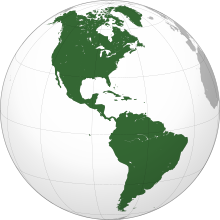
A | B | C | D | E | F | G | H | CH | I | J | K | L | M | N | O | P | Q | R | S | T | U | V | W | X | Y | Z | 0 | 1 | 2 | 3 | 4 | 5 | 6 | 7 | 8 | 9
| Area | 42,549,000 km2 (16,428,000 sq mi) |
|---|---|
| Population | 1.02 billion[1] |
| Population density | 22.67/km2 (58.74/sq mi) |
| Demonym | American,[2] Pan-American,[3] New Worlder[4] (see usage) |
| Countries | 35 |
| Languages | Spanish, English, Portuguese, French, Haitian Creole, Quechua, Guaraní, Aymara, Nahuatl, Dutch and many others |
| Time zones | UTC−10:00 to UTC |
| Largest cities | List
Complete List of largest metropolitan areas and their cities |
| UN M49 code | 019 – Americas001 – World |

The Americas, sometimes collectively called America,[5][6][7] are a landmass comprising the totality of North and South America.[8][9][10] The Americas make up most of the land in Earth's Western Hemisphere and comprise the New World.[5]
Along with their associated islands, the Americas cover 8% of Earth's total surface area and 28.4% of its land area. The topography is dominated by the American Cordillera, a long chain of mountains that runs the length of the west coast. The flatter eastern side of the Americas is dominated by large river basins, such as the Amazon, St. Lawrence River–Great Lakes basin, Mississippi, and La Plata. Since the Americas extend 14,000 km (8,700 mi) from north to south, the climate and ecology vary widely, from the arctic tundra of Northern Canada, Greenland, and Alaska, to the tropical rain forests in Central America and South America.
Humans first settled the Americas from Asia between 20,000 and 16,000 years ago. A second migration of Na-Dene speakers followed later from Asia. The subsequent migration of the Inuit into the neoarctic around 3500 BCE completed what is generally regarded as the settlement by the indigenous peoples of the Americas.
The first known European settlement in the Americas was by the Norse explorer Leif Erikson.[11] However, the colonization never became permanent and was later abandoned. The Spanish voyages of Christopher Columbus from 1492 to 1504 resulted in permanent contact with European (and subsequently, other Old World) powers, which eventually led to the Columbian exchange and inaugurated a period of exploration, conquest, and colonization whose effects and consequences persist to the present. The Spanish presence involved the enslavement of large numbers of the indigenous population of America.[12]
Diseases introduced from Europe and West Africa devastated the indigenous peoples, and the European powers colonized the Americas.[13] Mass emigration from Europe, including large numbers of indentured servants, and importation of African slaves largely replaced the indigenous peoples in much of the Americas.
Decolonization of the Americas began with the American Revolution in the 1770s and largely ended with the Spanish–American War in the late 1890s. Currently, almost all of the population of the Americas resides in independent countries; however, the legacy of the colonization and settlement by Europeans is that the Americas share many common cultural traits, most notably Christianity and the use of West European languages: primarily Spanish, English, Portuguese, French, and, to a lesser extent, Dutch.
The Americas are home to more than a billion inhabitants, two-thirds of whom reside in the United States, Brazil, and Mexico. It is home to eight megacities (metropolitan areas with ten million inhabitants or more): Greater Mexico City (21.2 million), São Paulo (21.2 million), New York City (19.7 million), Los Angeles (18.8 million), Buenos Aires (15.6 million),[14] Rio de Janeiro (13.0 million), Bogotá (10.4 million), and Lima (10.1 million).
Etymology and naming

The name "America" was first recorded in 1507. A two-dimensional globe created by Martin Waldseemüller was the earliest recorded use of the term.[16] The name was also used (together with the related term Amerigen) in the Cosmographiae Introductio, apparently written by Matthias Ringmann, in reference to South America.[17] It was applied to both North and South America by Gerardus Mercator in 1538. "America" derives from Americus, the Latin version of Italian explorer Amerigo Vespucci's first name.
The feminine form America was originally used to refer to the newly discovered continent, which is why it was accorded with the feminine names of the other continents: Asia, Africa, and Europa.[18]
Since the 1950s,[19] however, North and South America have generally been considered by English speakers as separate continents, and taken together are called the Americas, or more rarely America.[20][21][5] When conceived as a unitary continent, the form is generally the continent of America in the singular. However, without a clarifying context, singular America in English commonly refers to the United States of America.[5]
History
Pre-Columbian era
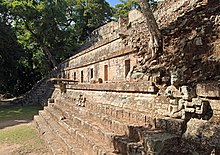
The pre-Columbian era incorporates all period subdivisions in the history and prehistory of the Americas before the appearance of significant European influences on the American continents, spanning the time of the original settlement in the Upper Paleolithic to European colonization during the Early Modern period. The term Pre-Columbian is used especially often in the context of the great indigenous civilizations of the Americas, such as those of Mesoamerica (Olmec, Toltec, Teotihuacano, Zapotec, Mixtec, Aztec, Maya) and the Andean civilizations (Inca, Moche, Chavín, Muisca, Cañari).
Many pre-Columbian civilizations established characteristics and hallmarks which included permanent or urban settlements, agriculture, civic and monumental architecture, and complex societal hierarchies. Some of these civilizations had long faded by the time of the first permanent European arrivals (c. late 15th–early 16th centuries), and are known only through archeological investigations. Others were contemporary with this period, and are also known from historical accounts of the time. A few, such as the Maya, had their own written records. However, most Europeans of the time viewed such texts as pagan, and much was destroyed in Christian pyres. Only a few hidden documents remain today, leaving modern historians with glimpses of ancient culture and knowledge.[22]
Settlement

The first inhabitants migrated into the Americas from Asia. Habitation sites are known in Alaska and Yukon from at least 20,000 years ago, with suggested ages of up to 40,000 years.[24][25][26] Beyond that, the specifics of the Paleo-Indian migration to and throughout the Americas, including the dates and routes traveled, are subject to ongoing research and discussion.[27] Widespread habitation of the Americas occurred after the Late Glacial Maximum, from 16,000 to 13,000 years ago.[26][28]

The traditional theory has been that these early migrants moved into the Beringia land bridge between eastern Siberia and present-day Alaska around 40,000–17,000 years ago,[29] when sea levels were significantly lowered during the Quaternary glaciation.[27][30] These people are believed to have followed herds of now-extinct pleistocene megafauna along ice-free corridors that stretched between the Laurentide and Cordilleran ice sheets.[31] Another route proposed is that, either on foot or using primitive boats, they migrated down the Pacific coast to South America.[32] Evidence of the latter would since have been covered by a sea level rise of hundreds of meters following the last ice age.[33] Both routes may have been taken, although the genetic evidences suggests a single founding population.[34] The micro-satellite diversity and distributions specific to South American Indigenous people indicates that certain populations have been isolated since the initial colonization of the region.[35]
A second migration occurred after the initial peopling of the Americas;[36] Na Dene speakers found predominantly in North American groups at varying genetic rates with the highest frequency found among the Athabaskans at 42% derive from this second wave.[37] Linguists and biologists have reached a similar conclusion based on analysis of Amerindian language groups and ABO blood group system distributions.[36][38][39][40] Then the people of the Arctic small tool tradition, a broad cultural entity that developed along the Alaska Peninsula, around Bristol Bay, and on the eastern shores of the Bering Strait c. 2,500 BCE moved into North America.[41] The Arctic small tool tradition, a Paleo-Eskimo culture branched off into two cultural variants, including the Pre-Dorset, and the Independence traditions of Greenland.[42] The descendants of the Pre-Dorset cultural group, the Dorset culture was displaced by the final migrants from the Bering sea coast line, the Thule people (the ancestors of modern Inuit), by 1000 Common Era (CE).[42]
Norse colonization
Around the same time as the Inuit migrated into Greenland, Viking settlers began arriving in Greenland in 982 and Vinland shortly thereafter, establishing a settlement at L'Anse aux Meadows, near the northernmost tip of Newfoundland.[43] Contact between the Norse colonies and Europe was maintained, as James Watson Curran states:
From 985 to 1410, Greenland was in touch with the world. Then silence. In 1492 the Vatican noted that no news of that country "at the end of the world" had been received for 80 years, and the bishopric of the colony was offered to a certain ecclesiastic if he would go and "restore Christianity" there. He didn't go.[44]
Large-scale European colonization

Although there had been previous trans-oceanic contact, large-scale European colonization of the Americas began with the first voyage of Christopher Columbus in 1492. The first Spanish settlement in the Americas was La Isabela in northern Hispaniola. This town was abandoned shortly after in favor of Santo Domingo de Guzmán, founded in 1496, the oldest American city of European foundation. This was the base from which the Spanish monarchy administered its new colonies and their expansion. Santo Domingo was subject to frequent raids by English and French pirates.
On the continent, Panama City on the Pacific coast of Central America, founded on August 15, 1519, played an important role, being the base for the Spanish conquest of South America. Conquistador Lucas Vázquez de Ayllón established San Miguel de Guadalupe, the first European settlement in what is now the United States, on the Pee Dee River in South Carolina.[45] During the first half of the 16th century, Spanish colonists conducted raids throughout the Caribbean Basin, bringing captives from Central America, northern South America, and Florida back to Hispaniola and other Spanish settlements.[46]
France, led by Jacques Cartier and Giovanni da Verrazzano,[47] focused primarily on North America. English explorations of the Americas were led by Giovanni Caboto[48] and Sir Walter Raleigh. The Dutch in New Netherland confined their operations to Manhattan Island, Long Island, the Hudson River Valley, and what later became New Jersey. The spread of new diseases brought by Europeans and African slaves killed many of the inhabitants of North America and South America,[49][50] with a general population crash of Native Americans occurring in the mid-16th century, often well ahead of European contact.[51] One of the most devastating diseases was smallpox.[52]
European immigrants were often part of state-sponsored attempts to found colonies in the Americas. Migration continued as people moved to the Americas fleeing religious persecution or seeking economic opportunities. Millions of individuals were forcibly transported to the Americas as slaves, prisoners or indentured servants.
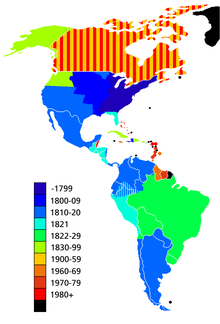
Decolonization of the Americas began with the American Revolution and the Haitian Revolution in the late 1700s. This was followed by numerous Latin American wars of independence in the early 1800s. Between 1811 and 1825, Paraguay, Argentina, Chile, Gran Colombia, the United Provinces of Central America, Mexico, Brazil, Peru, and Bolivia gained independence from Spain and Portugal in armed revolutions. After the Dominican Republic won independence from Haiti, it was re-annexed by Spain in 1861, but reclaimed its independence in 1865 at the conclusion of the Dominican Restoration War. The last violent episode of decolonization was the Cuban War of Independence which became the Spanish–American War, which resulted in the independence of Cuba in 1898, and the transfer of sovereignty over Puerto Rico from Spain to the United States.
Peaceful decolonization began with the United States's purchase of Louisiana from France in 1803, Florida from Spain in 1819, of Alaska from Russia in 1867, and the Danish West Indies from Denmark in 1916. Canada became independent of the United Kingdom, starting with the Balfour Declaration of 1926, Statute of Westminster 1931, and ending with the patriation of the Canadian Constitution in 1982. The Dominion of Newfoundland similarly achieved independence under the Balfour Declaration and Statute of Westminster, but relinquished self-rule in 1934.[53] It was subsequently confederated with Canada in 1949.
The remaining European colonies in the Caribbean began to achieve peaceful independence well after World War II. Jamaica and Trinidad and Tobago became independent in 1962, and Guyana and Barbados both achieved independence in 1966. In the 1970s, the Bahamas, Grenada, Dominica, St. Lucia, and St. Vincent and the Grenadines all became independent of the United Kingdom, and Suriname became independent of the Netherlands. Belize, Antigua and Barbuda, and Saint Kitts and Nevis achieved independence from the United Kingdom in the 1980s.
Geography
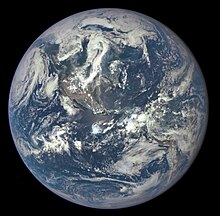
Extent
The Americas make up most of the land in Earth's Western Hemisphere.[54] The northernmost point of the Americas is Kaffeklubben Island, which is the most northerly point of land on Earth.[55] The southernmost point is the islands of Southern Thule, although they are sometimes considered part of Antarctica.[56] The mainland of the Americas is the world's longest north-to-south landmass. The distance between its two polar extremities, Murchison Promontory on the Boothia Peninsula in northern Canada and Cape Froward in Chilean Patagonia, is roughly 14,000 km (8,700 mi).[57] The mainland's most westerly point is the end of the Seward Peninsula in Alaska; Attu Island, further off the Alaskan coast to the west, is considered the westernmost point of the Americas. Ponta do Seixas in northeastern Brazil forms the easternmost extremity of the mainland,[57] while Nordostrundingen, in Greenland, is the most easterly point of the continental shelf.
Geology
South America broke off from the west of the supercontinent Gondwana around 135 million years ago, forming its own continent.[58] Around 15 million years ago, the collision of the Caribbean Plate and the Pacific Plate resulted in the emergence of a series of volcanoes along the border that created a number of islands. The gaps in the archipelago of Central America filled in with material eroded off North America and South America, plus new land created by continued volcanism. By three million years ago, the continents of North America and South America were linked by the Isthmus of Panama, thereby forming the single landmass of the Americas.[59] The Great American Interchange resulted in many species being spread across the Americas, such as the cougar, porcupine, opossums, armadillos and hummingbirds.[60]
Topography
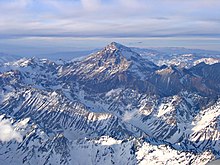
The geography of the western Americas is dominated by the American Cordillera, with the Andes running along the west coast of South America[61] and the Rocky Mountains and other North American Cordillera ranges running along the western side of North America.[62] The 2,300-kilometer-long (1,400 mi) Appalachian Mountains run along the east coast of North America from Alabama to Newfoundland.[63] North of the Appalachians, the Arctic Cordillera runs along the eastern coast of Canada.[64]
The largest mountain ranges are the Andes and Rocky Mountains. The Sierra Nevada and the Cascade Range reach similar altitudes as the Rocky Mountains, but are significantly smaller. In North America, the greatest number of fourteeners are in the United States, and more specifically in the U.S. state of Colorado. The highest peaks of the Americas are located in the Andes, with Aconcagua of Argentina being the highest; in North America Denali (Mount McKinley) in the U.S. state of Alaska is the tallest.
Between its coastal mountain ranges, North America has vast flat areas. The Interior Plains spread over much of the continent, with low relief.[65] The Canadian Shield covers almost 5 million km2 of North America and is generally quite flat.[66] Similarly, the north-east of South America is covered by the flat Amazon basin.[67] The Brazilian Highlands on the east coast are fairly smooth but show some variations in landform, while farther south the Gran Chaco and Pampas are broad lowlands.[68]
Climate

The climate of the Americas varies significantly from region to region. Tropical rainforest climate occurs in the latitudes of the Amazon, American cloud forests, southeastern Florida and Darién Gap. In the Rocky Mountains and Andes, dry and continental climates are observed. Often the higher altitudes of these mountains are snow-capped.
Southeastern North America is well known for its occurrence of tornadoes and hurricanes, of which the vast majority of tornadoes occur in the United States' Tornado Alley,[69] as well as in the southerly Dixie Alley in the North American late-winter and early spring seasons. Often parts of the Caribbean are exposed to the violent effects of hurricanes. These weather systems are formed by the collision of dry, cool air from Canada and wet, warm air from the Atlantic.
Hydrology
With coastal mountains and interior plains, the Americas have several large river basins that drain the continents. The largest river basin in North America is that of the Mississippi, covering the second largest watershed on the planet.[70] The Mississippi-Missouri river system drains most of 31 states of the U.S., most of the Great Plains, and large areas between the Rocky and Appalachian mountains. This river is the fourth longest in the world and tenth most powerful in the world.
In North America, to the east of the Appalachian Mountains, there are no major rivers but rather a series of rivers and streams that flow east with their terminus in the Atlantic Ocean, such as the Hudson River, Saint John River, and Savannah River. A similar instance arises with central Canadian rivers that drain into Hudson Bay; the largest being the Churchill River. On the west coast of North America, the main rivers are the Colorado River, Columbia River, Yukon River, Fraser River, and Sacramento River.
The Colorado River drains much of the Southern Rockies and parts of the Basin and Range Province. The river flows approximately 1,450 miles (2,330 km) into the Gulf of California,[71] during which over time it has carved out natural phenomena such as the Grand Canyon and created phenomena such as the Salton Sea. The Columbia is a large river, 1,243 miles (2,000 km) long, in central western North America and is the most powerful river on the West Coast of the Americas. In the far northwest of North America, the Yukon drains much of the Alaskan peninsula and flows 1,980 miles (3,190 km)[72] from parts of Yukon and the Northwest Territory to the Pacific. Draining to the Arctic Ocean of Canada, the Mackenzie River drains waters from the Arctic Great Lakes of Arctic Canada, as opposed to the Saint-Lawrence River that drains the Great Lakes of Southern Canada into the Atlantic Ocean. The Mackenzie River is the largest in Canada and drains 1,805,200 square kilometers (697,000 sq mi).[73]
The largest river basin in South America is that of the Amazon, which has the highest volume flow of any river on Earth.[74] The second largest watershed of South America is that of the Paraná River, which covers about 2.5 million km2.[75]
Ecology
North America and South America began to develop a shared population of flora and fauna around 2.5 million years ago, when continental drift brought the two continents into contact via the Isthmus of Panama. Initially, the exchange of biota was roughly equal, with North American genera migrating into South America in about the same proportions as South American genera migrated into North America. This exchange is known as the Great American Interchange. The exchange became lopsided after roughly a million years, with the total spread of South American genera into North America far more limited in scope than the spread of North American genera into South America.[76]
Countries and territories
There are 35 sovereign states in the Americas, as well as an autonomous country of Denmark, three overseas departments of France, three overseas collectivities of France,[77] and one uninhabited territory of France, eight overseas territories of the United Kingdom, three constituent countries of the Netherlands, three public bodies of the Netherlands, two unincorporated territories of the United States, and one uninhabited territory of the United States.[78]


